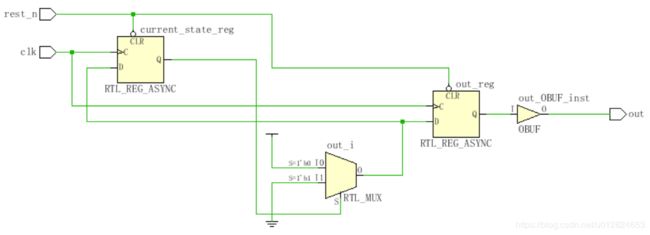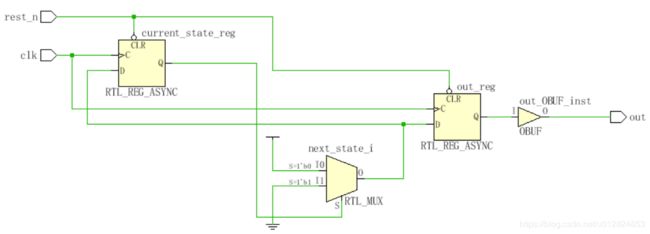三种状态机——分析、对比和小结
本文简化所有逻辑重点讲解状态机的框架。
先给几点小结:
小结1.在原理图和实际变现上来说,一段式和三段式完全一致,但在代码量大的情况下三段式代码更容易维护。
小结2.二段式的输出由组合逻辑驱动,不仅可能输出毛刺,而且不利于时许约束、分析。
小结3.状态机有着流水线的“缺点”:上电之初若不全面指定初始状态,则可能有若干个时钟的无效输出。
状态机一般有3个基本组成要素:
要素1.新状态
要素2.当前状态
要素3.输出
当每个clk到来,要完成3个任务:
任务1.将“新状态”赋给“当前状态”
任务2.产生下一个“新状态”(可能包含组合逻辑)
任务3.根据“当前状态”产生输出(可能包含组合逻辑)
以下分别给出三种状态机的框架代码、原理图、仿真激励代码和仿真波形图
一段式:
形式上,丢掉“新状态”这个媒介,直接把新状态的值赋给“当前状态”,故没有任务2。
形式上,在一个触发器里完成任务1、3,但实际上这需要2个触发器,因为1个触发器只有一组输出/输入。
module one_state_machine(
input clk,
input rest_n,
output out
);
reg out,current_state,next_state;
always@(posedge clk or negedge rest_n) //״̬תӆ
begin
if(!rest_n)
begin out <= 1'd0;current_state <= 1'b0; end
else
case(current_state)
1'b0: begin out <= 1'b1;current_state <= 1'b1; end
1'b1: begin out <= 1'b0;current_state <= 1'b0; end
default:begin out <= 1'b0;current_state <= 1'b1; end
endcase
end
endmodule
二段式:
用1个触发器完成任务1,用一个组合逻辑完成任务2、3。最后的输出由组合逻辑驱动,可能会产生毛刺,不利于时序分析和优化。
module two_state_machine(
input clk,
input rest_n,
output out
);
reg out,current_state,next_state;
always@(posedge clk or negedge rest_n) //״̬תӆ
begin
if(!rest_n)
current_state<=1'b0;
else
current_state<=next_state;
end
always@(*)
begin
case(current_state)
1'b0: begin out = 1'd1; next_state = 1'b1; end
1'b1: begin out = 1'd0; next_state = 1'b0; end
default:begin out = 1'd0; next_state = 1'b1; end
endcase
end
endmodule
三段式:
一个触发器完成任务1,一个组合逻辑完成任务2,一个触发器完成任务3
module three_state_machine(
input clk,
input rest_n,
output out
);
reg out,current_state,next_state;
always@(posedge clk or negedge rest_n)
begin
if(!rest_n)
current_state<=1'b0;
else
current_state<=next_state;
end
always @ (current_state)
begin
case(current_state)
1'b0: next_state = 1'b1;
1'b1: next_state = 1'b0;
default:next_state = 1'b1;
endcase
end
always@(posedge clk or negedge rest_n)
begin
if(!rest_n)
out <= 1'd0;
else
case(current_state)
1'b0: out <= 1'd1;
1'b1: out <= 1'd0;
default:out <= 1'd0;
endcase
end
endmodule
仿真激励代码:
`timescale 1ns / 1ps
module testbench_one_state_machine;
reg clk,rest_n;
wire out;
one_state_machine U0 (
.clk(clk),
.rest_n(rest_n),
.out(out)
);
initial
begin// this process block specifies the stimulus.
rest_n = 0;
#50
rest_n = 1;
end
initial begin
clk = 0;
forever #10 clk = ~clk;
end
endmodule
本文逻辑简单,三种状态机波形几乎一致。



